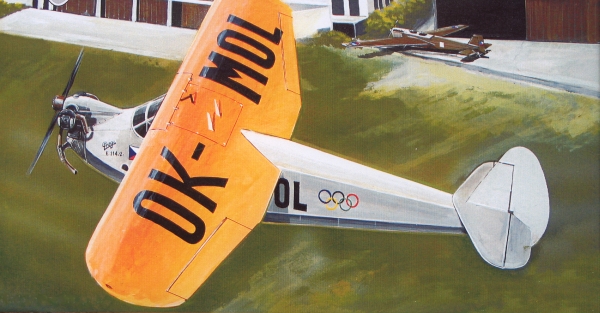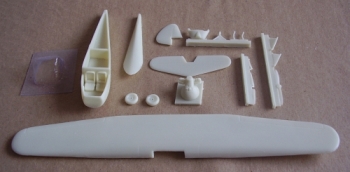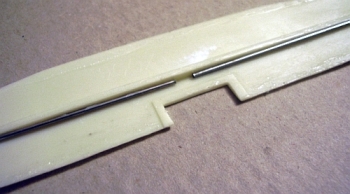

The The Praga E.114 was a single-engine sport airplane, designed by Jaroslav Slechta and manufactured by the Prague company CKD-Praga. The prototype flew for the first time in 1934 and the aircraft was introduced to the public at the Paris aero salon at the same year.
Series production started in 1935 with an aircraft equipped with a 29 kW Praga B engine. One year later appeared the higher performing version E.115, which was equipped with 44 kW Praga D engine. Two E.114s participated in the Sternflug to the 1936 Summer Olympics in Berlin. The two E.114 pilots, Fuksa and Polma, took the first two places, winning over competitors, equipped with aircraft with stronger engines. An aircraft of this type excited attention with a flight from London to Capetown. It flew 14,722 km in 14 days.
It was used by aeroclubs, private companies even as journalist's aircraft. It was exported to quite a lot of countries as Great Britain, France, Hungary, Sweden, Japan or Egypt. During two WW2 Luftwaffe and Slovak Air Force was using the type. In Czechoslovakia remaind only one piece after the war.
The British enterprise Hills & Sons acquired the manufacturing license and built the E.114 as the Hilson Praga at their factory at Trafford Park, Manchester. Hillson built a total of 28 aircraft.
More about Praga E-114 on wikipedia

The Legato resin kit is pretty simple, as you see on the picture, there are some 15 resin parts and vacuform canopy. There are decals for three airplanes; Czechoslovak aircraft that won Silver medal (piloted by cpt. Polma) on Olympic games 1936 in Berlin, British built Hilson-Praga and an airplane that ended up in Luftwafe service after the ocupation of Czechoslovakia by Nazis. The instruction sheet is in Czech and English. As this was my first resin model and the documentation is pretty rare on this type, I decided to make it out of box with few added scratch-built details to improve the cockpit.

First I cleaned parts. This was the toughest part as it quite a bit of resin to take off, the parts are quite small and sometime not very clear borders.
Then I started with the wing, Before gluing top and bottom parts together, I added two metal syringe needles inside and then glued it. It took some Miliput to for the little gaps between the parts and more importantly sanding of a trailing edge of the wing as this comes out too thick. Then I cut of the ailerons, some Miliput and sanding again. When I was satisfied with the result, I left them to be attached later.
Next step was to put together the fuselage that consist basically of three parts, the bottom one, and the front and rear top. This was quite a chalange as the shape of the rear top is on one side not very clear and the wing has to fit into a 'corner', so it took a lot of dry fitting before assembly.
Then the only modification I made was the cockpit came up. There are seats as part of the fuselage and the instrument panel, I tried to find some references with not much success, so I decided to add only some general looking belts, sticks and headrest, as this can be seen through the 'glass'. I painted the panel flat black and dry brushed the instruments with white, glued it to the front top part (again dry fitting pays of to be able to glue the set to the main fuselage part). The fasten belts are made of paper, painted with the beige and the sticks a made from the plastic painted it gray with black handles.
And then was the time to glue the Engine part (the screw and figuring out the exhaust pipes I left till the end of the completion).
At this moment I sprayed the whole model with the 1000 Surfacer, checked the surface of the model and repaired few places by polishing them. After that I sprayed the wings with yellow and the fuselage with light grey (some sources are showing silver or beige colour f the fuselage)
I choose an Olympic games aircraft of cpt. Polma as I wanted to have this plane in Czech markings and I liked the yellow/grey.
I painted interior before assembling the fuselage with the light grey mixing the tone that I supposed was more less correct (used references from other Czechoslovak fighters) And then applyed a bit of oil paint to get out detail.
When the assembly was done, missing the canopy and the screw, I covered the cabin and sprayed the blue all over the plane, using once more mixed tone using the colour instruction sheet as a guide, as the codes of colours are not in the instruction at all. Then I continued with details, masked the wheel disks (yes, I sprayed them blue first :)) and hand painted the rubber, using dark grey colour Last, I painted the propeler pretending wood and glued into its place. Last, I hand painted the canopy frames and glued it with the superglue.
Before applying the decals I sprayed the whole bit with gloss varnish, applied decals and sprayed the model again with semi-gloss varnish, As the plain participated in the competition, I presumed to be pretty "shinny", so I only added a bit of smoke traces on the sides of the fuselage.
Nice, neat, simple, althought a bit tricky to build, model of the "forgotten" Czechoslovak plane.
June 2009